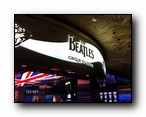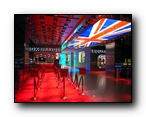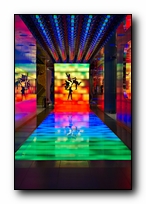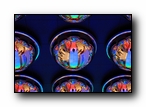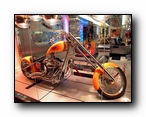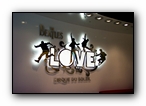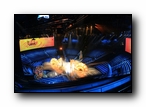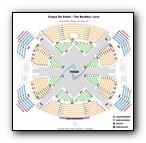
![]()

[ You are here: Grand Chapiteau | Creations | The Beatles LOVE | Odyssey: Scénographie ]
Création
Expérience
RetiréOdyssey
Picture yourself in a boat on a river. Characters from Beatles' songs cavort all around you. There's Lucy, Eleanor Rigby, Doctor Robert, Lady Madonna, and Sgt. Pepper. Suddenly, someone is there at the turnstile: it's the ticket taker, dressed like an English Bobby, welcoming you to LOVE, the Cirque du Soleil spectacular in residence at The Mirage, in a totally redesigned space that was occupied for many years by Siegfried and Roy. LOVE turns a corner for Cirque du Soleil in several ways: it is their first show without live music, as you hear The Beatles singing their own songs in an elaborate remix; it represents a unique collaboration with The Beatles' Apple Corp.; and moves the company's performance vernacular more toward pure entertainment and a little further from the circus-style acrobatic acts upon which Cirque du Soleil built its stellar reputation. Conceived by Cirque guru Guy Laliberté (based on an understanding with the late Beatle, George Harrison) and directed by Dominic Champagne, Contortionists and Chinese acrobats have given way to dancers, but in typical Cirque style, performers fly in from overhead while others blow giant bubbles using special liquid housed in a piano, and umbrellas are outfitted with lights and fog machines, as this 90-minute magical mystery tour takes the audience inside the Beatles song book from "A Day in the Life" to "The Word".
The original concept was to bring The Beatles' songs to life, rather than chronicle their lives. Yet the show does move in a chronological order, from the blitz of London in WWII to the psychedelic flower power era of the late 1960s by way of the Beatles' prolific musical oeuvre. Snippets of their famous appearance on the Ed Sullivan show, album covers, newspaper headlines, and photographs of the Fab Four at various stages in their career are part of the visual landscape of the show.
This 60's vibe begins the moment you step foot in front of the theater area. The lobby, box office, and gift shop areas are colorfully lit with Traxon Mood Lights, color-changing LED panels that also create a walkway into the inner lobby, with the color scheme a series of fades from red to pink to white. Color Kinetics ColorBlast fixtures add sparkle to the ceiling, where one area has colored fluorescent fixtures above glass panels to form a Union Jack, while Zumtobel fixtures outfitted with Color Kinetic's LEDs are set into the floor. The stairs leading from the concession area up to the theatre are lit with Martin Professional Alien 02 fixtures with 50W lamps. Rabasse also designed the lobby with a 1960s theme. "The lobby is basically white on your way into the theatre, but since you've been changed by the experience of the show, there is more color on the way out," explains Hills. The day look for the box office and gift shop (where there are also architectural fixtures by Indy Lighting and Erco Lighting) is also different from the pre-show look. Jean Rabasse does not distinguish between the interior of the theatre and the set design of LOVE. In his view the two are so intertwined that it's impossible to say where the interior of the building ends and the décor begins. The core concept of the design grew from the idea of surrounding the Beatles in a "bubble." The first order of business was redesigning the Siegfried and Roy venue for Cirque's new show. Rabasse not only completely gutted the classical 1,500-seat proscenium layout, but also extended it by 50 feet in all directions (adding 513 seats in the process), re-focusing everything toward the center of the room in an in-the-round layout. In a sense, he was also recreating the atmosphere and sensations of the big top-within a permanent structure. "The space is like a modified tent, which gives it an amazing intimate feeling," explains Michael Anderson, operations production manager for LOVE. Construction began in August 2005 and the load-in was the following November. The full crew was on board as of December 6th, and by June 2006, the show was up and running. "That is a fast turnaround for Cirque in a new facility," adds Anderson. MarnellCarrao Associates of Las Vegas served as the general contractors. Total Cost: $125 million USD. Construction required digging down an extra 20 feet for the automation systems required for the show. There are three main theater levels that the crew works on during the show: the basement 81 foot level, the 100 foot main stage and backstage level, and the low-grid 152 foot level. There is also the sub-basement, 10 feet below the basement level, where the motors and automation machinery is stored, and a high grid above the stage from the pre-existing Siegfried & Roy stage structures. Basically what was left in the space is the supporting wall of the proscenium arch, which cuts the tent-like interior into sections and makes for some rather unusual seating configurations. The center of the space, where the old proscenium opening was, is an 8-foot gapnow referred to as "Abbey Road," which is used to fly scenery in and out of the dividing line and for acrobatics. Six entrances/exits lead to and from the stage, with four control booths - lighting, projection, stage management, and automation - one at each corner of the theatre. Robert Juliat followspots are located in "garages" in the corners of the room, while the sound console is in the seating section along the south wall. A shop for electrics, rigging, automation, and projection is located where Siegfried and Roy's famed lions and tigers once lounged. "There is a running crew of 70 people, and another 28 for maintenance, broken down into different departments," Anderson adds, listing sound, props, electrics, projections, rigging, wardrobe, automation, and carpentry. In keeping with the intimate feeling of a circus big top, the farthest seats in the LOVE theatre, those in the last row of the balcony, are just 98 feet from the stage, and a mere 28 feet from the center of the stage to the first row. Auerbach Pollock Friedlander, performing arts/media facilities planning and design consultants, created the drawings and designed many of the theatrical systems, working hand-in-hand with Cirque du Soleil on the new arena seating, 25,000 square feet of overhead technical support, sound and communications systems, and a fully automated stage deck. The look of the open stage is deceptively simple: with 141 automation axes, it is one of the most sophisticated scenic automation installations in any theatre to date. The stage is made up of five main lifts constructed by Show Canada. In addition, there are two "sloats"-sliding lid over automated trap-two trampoline lifts, and four triangle dual axis traps, all built by Conception D. Bédard in Montreal. "The four hinged trap decks combined with the stage lifts allow the stage area to be transformed into a 1,600 square foot black hole, giving the visually stunning appearance of a void which only moments before was filled with scenic elements," explains Len Auerbach, principal of Auerbach Pollock Friedlander, who also worked on the show's extensive rigging and automation systems. And rather than using hydraulics to move the lifts, the lifts for LOVE use a rack and pinion system. (85% of the floor is mobile, only 15% doesn't open.) The rigging system includes four overhead tracks as well as nine motorized overhead trolleys that are integrated with wireless controls and travel at a maximum speed of six feet per second for transporting scenery and performers. Designed and manufactured by Stage Technologies Inc. based in the UK and Las Vegas, "These units are the key to the overhead acrobatics using the three dimensional space in the theatre," explains Auerbach. "The trolleys are fitted with vertical hoists on a rotational axis. A typical trolley unit consists of four vertical hoists mounted on a rotating chassis, allowing performers or scenery to be moved vertically or horizontally while rotating simultaneously." There are a total of 22 vertical hoists, eight rotating chassis, and 12 fixed winch assemblies that are positioned on the grid surface to assist with the movement of scenic elements in and out of the space. Kevin Taylor, CEO of Stage Technologies Inc., worked very closely with the team in the initial months of rehearsals and continues to offer 24-hour support with the assistance of Stage Technologies specialized engineers based in the US and UK. The production communications system, also worked on by the theatre consultants, includes a 72-port digital matrix intercom system interconnected with a digitally controlled analog matrix, capable of switching 216 stations into eight party-lines. The system provides ten channels of wireless intercom feeding 20 wireless beltpacks. Backstage monitoring and paging is controlled by a computer-based system feeding over 82 loudspeakers. (The system is a mix of Clear-Com, Motorola, and Telex.) More than 20 fixed-focus and remote-controllable color video cameras are routed through a 26-channel modulated video system for monitoring of performers, musicians, and critical backstage systems. It all sounds complicated – and it is! But the greatest challenge for Jean Rabasse was in allowing for seamless transitions between scenes with complex decors. For example, the show opens in the sky and then the scene dissolves to the rooftops of London for the Beatles' last concert atop their building in Savile Row, and from there it travels to the gritty ruins of wartime Liverpool. But he succeeded.
Deans says the fact that LOVE is based on the music of the Beatles posed a huge challenge above and beyond the regular demands of designing the sound for any other Cirque du Soleil show. The music itself needed to be something fans could hear nowhere else. It couldn't just be a simple playback of the Beatles' catalog. The original concepts discussed featured - in some cases - live musicians, perhaps playing orchestral content to playback of the group's music, others with soloists. "The problem was that some of the ideas would have made it not The Beatles. It would have been a tribute show. And we knew that we wanted to have The Beatles be there as much as we could. And to do that, they had to play the music; they had to be the ones whose voices we heard." Everything changed once The Beatles' original record producer, Sir George Martin, and his son, producer Giles Martin, were brought onboard as music directors for the show. The two arrived with another valuable asset: access to group's original multi-track recordings. "We sat down with Neil Aspinall, the head of Apple, who told us they didn't want anyone performing Beatles music," the younger Martin explains. "I said to him, 'You know... we could do something which is almost like The Beatles playing live, by using the session tapes, because the tapes are a live recording.' I thought, 'Why don't we just try and create a sort of surround experience from the tapes?' And off we went." "The music had to be sorted out before everything else started, to make sure The Beatles were happy," says Giles Martin. The assignment was a tricky one, as Cirque music is very different from Beatles music. To provide some direction, Deans made the trip to England to meet with the Martins to detail Cirque's needs. The Martins were also given a book put together by show concept writer and director Dominic Champagne, which offered a story line of the running order for the show. As for the songs to be represented, "Dominique had a wish list, and The Beatles had a wish list of songs they wanted to be in the show," Martin says. "Pacing is very important, as are song keys, and that took a little while to get right. You can't have 'She's Leaving Home' going into 'Yesterday,' because you're going from the key of E into F. But once that got worked out, then I just worked from the beginning of the show to the end." With everyone onboard, Giles Martin began work on the soundtrack, using the original Beatles master tapes in a specially secured room in the legendary Abbey Road Studios. People remember the pioneering sounds of The Beatles, but they may forget the technological limitations imposed on the group and Sir George Martin, who were often recording on one- or two-track tapes; this meant that effects were consolidated and bounced down from one track to another to get the heavily layered sounds for which The Beatles were known. "We were dealing with old recordings that might have everything together on one track," says Deans. However, for some songs, "they had the old bounce recordings still available. So suddenly you can get a better, wider approach." Martin went through the multi-track recordings for every single Beatles song, in order to prepare for creation of 110 minutes of music for the show. "I went through everything and made notes, looking for anything that looked interesting," says Martin. Session tapes for "Cry, Baby, Cry" from The Beatles (aka The White Album), for example, revealed an unusual accordion not used on the album. "I made note of it, and then, when I was working on ‘Being for the Benefit of Mr. Kite,' from Sgt. Pepper, which has a weird, circus-y sound, I said, ‘Ah - this is a good place for that.'" Eventually, only about 90 minutes worth was used, a total of 28 songs ("She's Leaving Home" and "Girl" were created but not used). The selection of songs and sounds that make up the intricately detailed mashup of a soundtrack, was, according to Deans, "a collective decision made by director Dominic Champagne, Sir George Martin, Giles Martin, the remaining Beatles, Yoko Ono, and Olivia Harrison [George Harrison's widow]. They all had ideas and opinions, and the process was spearheaded by Dominic Champagne, because, in the end, he had to make a production." Giles Martin took the song and soundtrack sequence, and created 32-track Pro Tools sessions, mixed into a 5.1 monitoring format, to be used as a starting point for the mixing process in the LOVE theatre. The hard drives containing the sessions were brought in and stored in the Mirage under high security. "We built the vaults," laughs Deans, "but I have never even seen the master drives." Working in ProTools HD, Martin carefully wove in individual tracks from different songs into the basic song being worked on, importing them onto separate tracks in the base song's session file. For "Octopus's Garden" (from 1969's Abbey Road), for example, Martin created an introduction using strings from The White Album's "Good Night." "Then, the drums are from "Lovely Rita" (from Pepper)," he notes, "but those were on top of the drums that were already there," with percussion also added from Abbey Road's "Polythene Pam," all added without making hard edits. "There are no cut points," he adds. "It's not like a ‘mashup.' This is really the first case of a band sampling themselves, actually." Martin kept constantly aware of the delicacy of the project. "It's kind of like painting a mustache on the Mona Lisa. People won't like the idea of anyone doing anything to these historical and beautiful songs" - except, of course, by the recordings' original producer.Giles' father kept a watchful eye on the entire proceedings, offering his son direction and feedback throughout as the two worked. "He obviously knows everything they did on the original recordings," says the younger Martin. "It was fascinating going through this stuff with him. And talk about an honor to be able to work on your dad's work." Martin continued work at an identical studio built for him by Deans at Cirque's offices in Montreal. ("The same four walls followed me," he says). Once the compilations were completed, 5.1 surround mixes were then created by Abbey Road engineer Paul Hicks. The mixes were essentially prepared for playback to The Beatles, who gave their final approval in December 2005. While Hicks' 5.1 mixes were appropriate for studio listening, a more elaborate mix - and playback system for it - was required for the in-the-round presentation in the theatre. The system, designed by Deans, allows importing of finished mixes from ProTools, played back on cue through a powerful, yet simple, audio system.Once the mixes were completed, playback operator Gavin Whiteley used Magix Sequoia V8 high definition digital audio workstation to break the files into manageable pieces before loading them into TASCAM GigaStudio. Each of the show sequences is then stored in Realtime Music Solutions Sinfonia MIDI sequence controller, which triggers the playback from GigaStudio through Level Control Systems (LCS) CueConsole desk, which has 88 inputs and 280 outputs. "We use Sequoia because it's able to look at samples in terms of bars, beats, and measures," explains Cirque's head of audio for the show, Jason Pritchard. "And when you're doing a sequence with Sinfonia, everything is in bars and beats, in order to allow us to have non-linear playback without any latency." Slight adjustments to mixes can be made in LCS, though major changes to mixes have to be made back at the ProTools level and re-imported through Sequoia, a process which can take up to three days per sequence. As for the playback system, Deans' speaker system is dominated by self-powered Meyer M1-D and CQ-1 speakers. 30 M1-Ds are set in arrays in the front of the stage. "That's two PAs in most places," says Pritchard. "There's a lot of power that comes off the front of the stage, and that's all in an effort to keep the image low, so that it doesn't sound as if The Beatles are always singing in the grid." Additional M1-Ds and M2-Ds provide surrounds, along with JBL 4825s and 4853s (left over from the previous Siegfried & Roy installation). "The JBLs create, essentially, a wall of sound that comes from the ceiling," Deans explains. Most interesting, though - and important to the sound picture - is the inclusion of 6,039 custom Innovox Audio speakers, installed in each of the 2,013 seats in the theatre (left, right, and a third in front of the patron). "The first thing was to find a company that could build a speaker that could not only fit in the seats, but that could be built out of cardboard and magnets," Deans explains. "I wanted those speakers to be of the same material that the music was originally mixed on, not DSP-driven cones." Does having those three speakers that close to the audience cause a distraction, or does it enhance the sound picture? Deans says no. "If you were to ask an audience member, I would say 50% of them would say, ‘Oh, there are speakers in the seats?'" Martin agrees. "It actually brings the image down. And it means you can stick John's or Paul's voice in your head."The resultant sound pictures hit the audience with, not a 5.1 mix (with six sources), but, as Deans says, "25.5" - about 25 or 26 individual sound sources. The sources, though, come from the complicated mixing - or remixing, in a sense - of Martin's compilations, accomplished by Martin, Hicks, Deans, and Deans' assistant, Leon Rothenberg. An identical ProTools rig was once again constructed at the Mirage, this time in a secure location, along with the drives containing the invaluable Beatles multi-tracks. The mix team would then sit, connected through a Cat 5 line, at any location within the theatre, to the ProTools system, and create the most appropriate mixes for each song. Starting, typically, with the 5.1 mix, the team would slowly identify elements of the recording to extract out and place in the sound picture - either forward in the M1-D front arrays, in speaker seats, surrounds, or elsewhere. "If there was a sound or a voice that corresponded to a character onstage, we might place it lower, higher, in the air - we'd focus the voice in the area where the audience would expect to hear it," Deans explains. The theatre was divided up into eight different sound zones. "The theatre is, to some degree, symmetrical," says Pritchard. The team would create a mix in one zone, and then, essentially, copy and paste the mix into its corresponding zone across the theatre. "The room isn't absolutely symmetrical, though, so we spent many, many nights walking around the theatre, sitting down in a chair, listening for 15 or 20 minutes, evaluating, and then making individual tweaks for the sections." Such tweaking had to be done with care. "The mixes created by Sir George, Giles, and Jonathan are very, very precise," adds Pritchard. "In this theatre, if we make 1/2 dB adjustment, it's noticeable." And slight anomalies hardly went unnoticed, even with weeks of fine tuning. Even at a late date, Martin says, "I think I've challenged them as much as I can. I'm still going, ‘Row K doesn't sound very good.' I'm a real nightmare," he laughs. The key, he says, is quality. "You can't bluff your way through it. Paul [McCartney] hears everything. And Yoko really cares whether she thinks John sounds good. With my bosses, they just really care about whether it's good or not." It's been a long haul and a lot of hard work to produce the result. "If it's not too corny," Martin says, "it's been a labor of love." One of the bigger challenges of the LOVE soundtrack is the fact that the tempo and structure of The Beatles' music, with every nuance known in excruciating detail by millions of fans, cannot be varied, while the dangers inherent in the Cirque performance style demand flexibility. The approach created by Deans and his team offers as much flexibility as possible in some very novel ways. One key to the flexibility is the Sinfonia system, which is designed for live musical performance as an orchestral enhancement system, capable of supplementing live musicians in a tempo and pitch-agile way, with a single musician performing any number of orchestral parts. It can be conducted beat by beat, or used with preset tempos, and it's used in the pit on many Cirque shows. On LOVE, however, they don't use Sinfonia to change pitch or tempo, it's just a sequencer to handle the massive sample files, and to be able to jump around in the show, should the need arise during an emergency. "The rhythm/tempo of the music is defined by Ringo, not by the sequence tempo," explains Gavin Whiteley, who performs the soundtrack each night. "During the show," says Deans, "we will never stop a song, unless someone is being squashed. But for rehearsal purposes, and for the transitions in the show, we needed the flexibility to go now from the second chorus, or from the first chorus, etc. So, between songs, there are links. Some are built-in and some [in the case of emergency] are for when it completely stops and goes silent, and they make an announcement." Seamlessly looping the pre-recorded soundtrack in musical ways was a major challenge. "A ‘vamp' can be programmed in Sinfonia," explains Whiteley, "that will jump to another part of the sequence, at precisely the right time, to repeat a section or play a different section." These loops can offer unique experiences for Beatles fanatics in the audience. "All possible loops have been approved by Giles Martin and Sir George Martin in advance," Whiteley explains, "ensuring that even when the music has to adapt to the action on stage, it has the seal of approval of the show's musical directors." And it's something they had to use on the night of the gala opening. With all the [surviving] Beatles and their families sitting together, the team needed to extend the music at the end of "For The Benefit of Mr. Kite" because of a delay in the automation system. This music is based on "I Want You (She's So Heavy)." Instead of looping the music again, they played out an extra 90 seconds of ‘I Want You' that was transferred from The Beatles' master tapes, but is normally not used in the show, and not available on any commercial recording. "So the entire cast and audience that night-including the surviving Beatles-heard what amounts to an unreleased ‘bonus track' through Jonathan Dean's sound system!" In addition to the performance audio system, the audio department is responsible for a number of other systems, including IFB (interrupted foldback-the earpieces TV newsreaders wear). This is something Cirque last did on KÀ and, on that show, the IFB allows the stage manager to talk directly to the performers onstage. "Currently," explains Pritchard, "the folks doing the bungie at the top of the show are on IFB to hear the calls from the riggers, who fly them." Pritchard's department is also responsible for another show system critical for LOVE: time code. Time code (TC) plays a hugely important role in LOVE, and its use marks probably the most extensive use of show control on a Cirque project yet. "It's SMPTE, LTC 30 non-drop," explains Pritchard. "The TC is stripped on a track of the playback system, and distributed to sound [for the Meyer/LCS console], lighting, and projections. In addition to the various systems that read the TC, there are also TC displays in the stage management booth. Many of the cues that are called by stage management are called on the clock." Time code, of course, was designed for continuous, linear applications, so looping and linking segments of indeterminate length created a lot of challenges. "Time code is played from GigaStudio on its own MIDI channel," explains Whiteley. "If we repeat a section of music, we are basically going back in time, but Sinfonia will mute the time code-effectively ‘freezing' it-then unmute it again when we return to the same place. TC will never go backwards, so none of the systems that respond to our time code will repeat a cue, or something worse." As you may have guessed by now, this was a labor-intensive effort. "I'm the sound designer," says Deans, "but it takes so many people to make it work."
Yves aimed to recreate the mood of the 1960s. "There were big changes in trends during that time," he notes. The color palette is bright and cheerful, turning psychedelic as the 60s progress. He wished to preserve the warmth, color and tones of that decade, from rock'n'roll to psychedelic. Yves was very much inspired by album covers, photographic news reports from the era, as well as the separation of photos in different colors and the stretching of images, which are trends that the Beatles themselves initiated with some of their album covers ("Rubber Soul" for example.) Therefore, the lighting rig is all exposed, based on the concept of being in a studio, with the fixtures hung against a black ceiling. At one point, a portion of the audience closest to the stage is covered with a large white cloth, and Aucoin paints it with psychedelic patterns that are best seen from the higher seats in the balcony. Yves created a very distinct world for each of the songs of LOVE. His biggest challenge was to work with a 360-degree stage, on which the front light shining on the action is actually also the back light for half of the spectators. His preferred color palette is a warm one, although the feeling on stage usually guides his choice of colors. "I am influenced by the music and the work of the Artists. I am usually the last Creator to make final adjustments to my work during the creation of a production." says Yves. As for fixtures, he says, "It's the first show in my life that I have just one brand of moving lights. Usually I mix and match but, when I put my dream list together, it was a question of noise. For a musical show, it was really important that we keep the noise level as low as possible. Vari-Lite offered that and, after that, it was a question of washes and type of light. For me, Vari-Lite is sexier - the way they move." Indeed, Aucoin's moving light rig includes 54 Vari*Lite VL3500Qs (that's Q for quiet), 64 VL3000Qs, 56 VL2500 Spots, and 30 VL3000Q Wash units. Also in the rig are 21 Martin Atomic 3000 strobes, just over 400 ETC Source Fours of varying types, 40 Altman Micro Strip MR 11s, eight Robert Juliat Ivanhoe followspots, 16 WildFire LT40F and 12 WildFire fluorescent UV units. The theatrical lighting system represents state-of-the-art technology with 916 ETC Sensor+ dimmers, an ETC ETCNet2 network with a fiber-optic backbone and routers for a series of VLANs, each with its own color-coded cable system. The ETCNet2 cables are black, for example; the MA Lighting grandMA is purple; and AMX touch screens, red. "The grandMA NSP processors translate back to the console, which speaks Net2," explains John Bartley, head of lighting for Love. The system also includes 60 portable ETCNet2 network nodes, 10 rack-mounted ETCNet2 nodes, and 24 racks of ETC SmartSwitch relays. The entire show is run on a grandMA console (with a back-up) with a grandMA Light to run the ETC SmartSwitch relays. "This is the second install where a grandMA talks directly to the ETCNet2 system," says Jim Holladay, senior project manager for PRG in Las Vegas, supplier of the dimming and control package; the fixtures came via Solotech USA. "In this case the network is even more complicated with an ETC Emphasis server to run the house lights in the theatre. For the lobby lights, the Emphasis server sends a DMX signal to an EQ control system." AMX touch screens serve as the user interface for the lobby and house lights, and are located throughout the theatre, both in the control room near the grandMA as well as in the house and backstage, providing separate systems "To keep the right people on the right page," notes Anderson. And as Holladay adds, "The AMX controllers are not easily programmable. They can change cues more quickly on the Emphasis system." The system has a total of 64 universes of DMX (not all of which are used at the moment), 32 of which are for the show's "MA world," and an additional six for the house lights and power, with all of the moving lights on relay power. "We have the same console and same protocol everywhere," says Anderson. "The ETCNet2 network is a better option than DMX cable." Real estate was one of the issues in installing the lighting system. "One of the biggest challenges was coordination," confirms Holladay. "We needed to be able to provide all the power distribution and dimmer locations while avoiding all the flying and rigging apparatus. We couldn't put pipes where the winches are, and there are a lot of them." One of the most spectacular scenes visually, is "Lucy In The Sky With Diamonds," when the entire theatre seems to sparkle under a canopy of light. "The LEDs used in 'Lucy' are Color Kinetics iColor Flex. We have approximately 4,000 individual LEDs that are individually addressed," explains John Bartley, head of lighting for LOVE. "The interesting thing is how we integrated them. The riggers came up with an ingenious elaborate fly system. Throughout the grid the strings all pulled back to a head block and arbor. We had custom tubes made to guide the light strings through the grid. We then integrated the network through our existing fiber backbone to get the control back to the Light System Manager in the booth. We created another network in the theatre. We used MOXA Ethernet-to-Fiber converters. Very cool product." Even the fog effects on this show are sophisticated. LOVE has a 3,000-gallon liquid nitrogen tank with a vaporizer to run the fogger propellants, and a Vacuum Barrier Corporation vacuum-jacketed piping system which feeds the MDG low-fog units. This system prevents the pipe from condensating by having a double-jacketed pipe with a vacuum between them. The vacuum is maintained by a pump. The lighting department's control over yet another system was critical for one amazing scene: "Within You, Without You" where a giant "bed sheet" is brought from the center of the stage to cover the entire audience. Later, the cloth is sucked away into a hole in the stage nearly as fast as it appeared; this is assisted by the lighting department's control over the building's air-handling systems. For control over the HVAC systems, the lighting department links to a system called "Tridian" through a web browser, which lets them control all the air handlers, dampers, and exhaust fans in the building. They can then pressurize the room as needed - effectively move air in any direction in the building. LOVE also uses an extensive AMX touch screen system. "We use it," explains Bartley," for Q-lights, house and lobby lights, stage theatrical work lights, and selected rehearsal lighting for the stage managers."
Lighting is used in other ways too, for projection as an example. Francis Laporte's projections for LOVE blur, bend, and extend the definitions of theatre design. They evoke time, place, and mood through a picture-perfect succession of moving images in a state of constant flux. Laporte's work seamlessly integrates digital video production and projection technology with the interior structure of the theatre, the show's lighting design, and the more traditional three-dimensional set elements featured in the production. The projections are run via a dedicated grandMA console, located in the projection booth, with 20 Green Hippo Hippotizer HD dual-output media servers with custom software doing the digital manipulations, and 20 DPI HIGHlite 12000Dsx projectors in five sets, double stacked on each side of the theatre for extra punch on two 103' wide × 20' curved screens that stretch along the north and south wall of the theatre (the same images are seen on both screens), pumping up to 250,000 lumens of light. In addition to these projectors, four additional DPI HIGHlite 12000Dsx projectors are on Brother, Brother & Sons v-Base moving projection yokes so they can swivel as needed to project on a central scrim that stretches across the stage, including a clever sequence in which projections of The Beatles recreate the famous Abbey Road crossing, and on various props such as the VW Beetles. "They almost act as if they are a moving light," says Anderson. Four DPI Lightning 30sx+ projectors on catwalks are used on large kabuki scrims and other screens that come in on diagonals. Four catwalks hold the projectors (an additional four catwalks are used for lighting and other gear). Above all, however, the projections must work in perfect synch with the music and the actions of the artists as they explore the journey of the characters inside the Beatles' songs and immerse the audience in the emotion of each scene. That is why Laporte deliberately avoided a high-tech look. Instead, he opted for a fluid mélange of shadows and silhouettes, archive footage, natural elements and pigmentation, photographic collage design, time-honored techniques such as watercolor and composite video images. To reflect the different eras in the story of the Beatles, the projections transform from sepia tones to kaleidoscopic design and from black and white images to a psychedelic parade of color. To achieve all this, he combined the latest technologies with a more established approach, using advanced high-definition digital technology to reinterpret the graphic techniques of the 60s. Many of the images are what Laporte refers to as "hand-crafted; more two-dimensional than 3D." He uses water and oil, collages, and colors that relate to the 60s, what he calls "Yellow Submarine colors. Yet I wanted everything to be as timeless as possible," he says. A clever sequence involves multiple pairs of yellow rubber rain boots, echoing a Michael Curry-created prop on stage where a dancer is in an armature with multiple pairs of the rubber boots attached as puppets. "The sequences were shot in Montreal, using high-definition video," explains Laporte. "The psychedelic world on stage is a little surreal. The boots as the stars of the video give another focus to what is onstage." Curry also created three full-scale VW Beetles used in the show, and two large-scale paper puppets for the "While My Guitar Gently Weeps" sequence. Laporte discovered that the Hippotizer gave him an advantage in staging the show. "The real time options such as scaling and color correction allow you to be as fast as the lighting designer in building a scene," he says. "There is no delay in rendering." His rendering farm was originally in Montreal, then moved to Las Vegas. "The files are huge and we used multiple computers," he adds. To create birds that fly in a natural way for "Yesterday," Laporte used Green Hippo's flocking program that allows the CGI birds to follow a target by using a joystick. This was developed in conjunction with Sean Westgate and the Green Hippo programming team. While Laporte worked on the ideas for various images, his media guru, Luc Lavergne, worked out the technical solutions. "Sometimes the simplest images are my favorite," says Laporte, pointing out that his images for "Strawberry Fields" were made by pouring white cream into a fish tank and shooting the movement in the water at high speed (400 frames per second). He then colored the results digitally. To create images of bubbles, Laporte put oil in water and blew with a straw. "It's hard to shoot bubbles," he explains. ‘They act as a mirror and you can see your reflection. With the oil there is no reflection." Not to mention that the mixing of oil and water is a perfect flashback to the psychedelic era of the 60s. "Computer bubbles look like computer bubbles. I wanted it to look more natural, more organic, with slow movement." Custom software directs the flow of crystal-clear panoramic moving images projected onto 100-ft-wide screens. A key element of the programming is the time-coded system that ensures the projections' programmed cues are synched up flawlessly with the recorded music used in the show. The system can respond in real time should that become necessary at any point during a show. The real-time authoring system also gave the show's creators the ability to mix and change multiple layers of images on the fly during rehearsals to create the exact mood and precise effect they were seeking for each act. Francis Laporte points out that the immense amount of technology employed for the projection system for LOVE is not only more elaborate than anything used in a previous Cirque du Soleil show, it goes beyond anything ever attempted in any permanent theatrical production in terms of its size, power, complexity and capabilities. "There is more media used in this show than any of the other Cirque shows." While this is the most technologically advanced theatre ever built, most of the technology is not on display and therefore does not come between the audience and their enjoyment of the show. In addition to the visible elements there is a highly sophisticated infrastructure at work behind the scenes and above the auditorium. By integrating the lighting, projections, acrobatic equipment and sound design into this environment, Rabasse has created the ideal immersive space in which to present the music of Beatles and the performances of the Cirque du Soleil artists. And for Rabasse, the central and constant role of his design is the music, and the way it sounds. "You can create true theatrical magic using simple techniques, and when it's integrated with the sound system that Jonathan Deans has created for LOVE the result is an experience that is completely immersive and totally involving," he says. |


